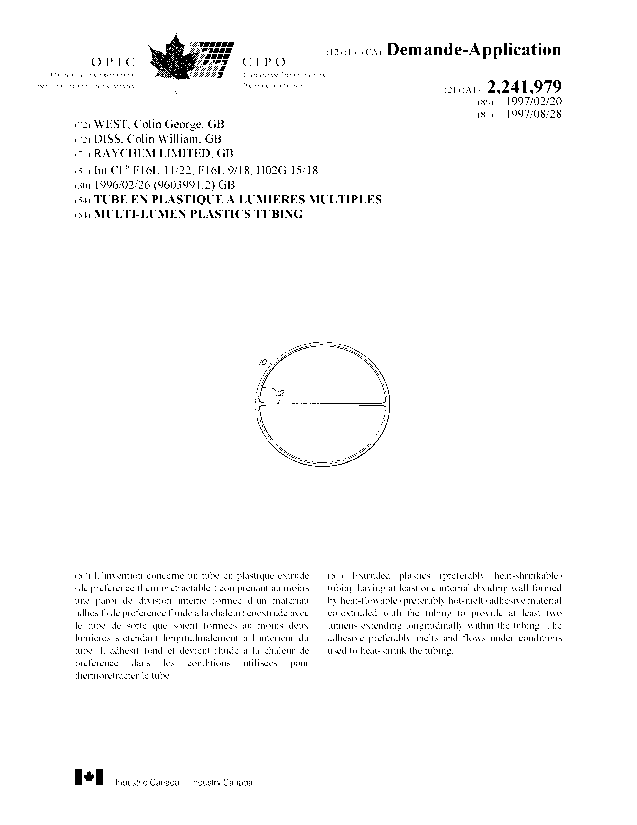Une partie des informations de ce site Web a été fournie par des sources externes. Le gouvernement du Canada n'assume aucune responsabilité concernant la précision, l'actualité ou la fiabilité des informations fournies par les sources externes. Les utilisateurs qui désirent employer cette information devraient consulter directement la source des informations. Le contenu fourni par les sources externes n'est pas assujetti aux exigences sur les langues officielles, la protection des renseignements personnels et l'accessibilité.
L'apparition de différences dans le texte et l'image des Revendications et de l'Abrégé dépend du moment auquel le document est publié. Les textes des Revendications et de l'Abrégé sont affichés :
| (12) Demande de brevet: | (11) CA 2241979 |
|---|---|
| (54) Titre français: | TUBE EN PLASTIQUE A LUMIERES MULTIPLES |
| (54) Titre anglais: | MULTI-LUMEN PLASTICS TUBING |
| Statut: | Réputée abandonnée et au-delà du délai pour le rétablissement - en attente de la réponse à l’avis de communication rejetée |
| (51) Classification internationale des brevets (CIB): |
|
|---|---|
| (72) Inventeurs : |
|
| (73) Titulaires : |
|
| (71) Demandeurs : |
|
| (74) Agent: | SMART & BIGGAR LP |
| (74) Co-agent: | |
| (45) Délivré: | |
| (86) Date de dépôt PCT: | 1997-02-20 |
| (87) Mise à la disponibilité du public: | 1997-08-28 |
| Licence disponible: | S.O. |
| Cédé au domaine public: | S.O. |
| (25) Langue des documents déposés: | Anglais |
| Traité de coopération en matière de brevets (PCT): | Oui |
|---|---|
| (86) Numéro de la demande PCT: | PCT/GB1997/000464 |
| (87) Numéro de publication internationale PCT: | GB1997000464 |
| (85) Entrée nationale: | 1998-07-02 |
| (30) Données de priorité de la demande: | ||||||
|---|---|---|---|---|---|---|
|
L'invention concerne un tube en plastique extrudé (de préférence thermorétractable ) comprenant au moins une paroi de division interne formée d'un matériau adhésif (de préférence fluide à la chaleur) coextrudé avec le tube de sorte que soient formées au moins deux lumières s'étendant longitudinalement à l'intérieur du tube. L'adhésif fond et devient fluide à la chaleur de préférence dans les conditions utilisées pour thermorétracter le tube.
Extruded plastics (preferably heat-shrinkable) tubing having at least one
internal dividing wall formed by heat-flowable (preferably hot-melt) adhesive
material co-extruded with the tubing to provide at least two lumens extending
longitudinally within the tubing. The adhesive preferably melts and flows
under conditions used to heat-shrink the tubing.
Note : Les revendications sont présentées dans la langue officielle dans laquelle elles ont été soumises.
Note : Les descriptions sont présentées dans la langue officielle dans laquelle elles ont été soumises.

2024-08-01 : Dans le cadre de la transition vers les Brevets de nouvelle génération (BNG), la base de données sur les brevets canadiens (BDBC) contient désormais un Historique d'événement plus détaillé, qui reproduit le Journal des événements de notre nouvelle solution interne.
Veuillez noter que les événements débutant par « Inactive : » se réfèrent à des événements qui ne sont plus utilisés dans notre nouvelle solution interne.
Pour une meilleure compréhension de l'état de la demande ou brevet qui figure sur cette page, la rubrique Mise en garde , et les descriptions de Brevet , Historique d'événement , Taxes périodiques et Historique des paiements devraient être consultées.
| Description | Date |
|---|---|
| Inactive : CIB de MCD | 2006-03-12 |
| Inactive : CIB de MCD | 2006-03-12 |
| Demande non rétablie avant l'échéance | 2003-02-20 |
| Réputée abandonnée - omission de répondre à un avis sur les taxes pour le maintien en état | 2003-02-20 |
| Inactive : Morte - RE jamais faite | 2003-02-20 |
| Inactive : Abandon.-RE+surtaxe impayées-Corr envoyée | 2002-02-20 |
| Inactive : CIB attribuée | 1998-10-29 |
| Inactive : CIB attribuée | 1998-10-29 |
| Inactive : CIB en 1re position | 1998-10-29 |
| Inactive : CIB attribuée | 1998-10-29 |
| Symbole de classement modifié | 1998-10-29 |
| Inactive : Notice - Entrée phase nat. - Pas de RE | 1998-09-11 |
| Demande reçue - PCT | 1998-09-08 |
| Demande publiée (accessible au public) | 1997-08-28 |
| Date d'abandonnement | Raison | Date de rétablissement |
|---|---|---|
| 2003-02-20 |
Le dernier paiement a été reçu le 2001-12-20
Avis : Si le paiement en totalité n'a pas été reçu au plus tard à la date indiquée, une taxe supplémentaire peut être imposée, soit une des taxes suivantes :
Les taxes sur les brevets sont ajustées au 1er janvier de chaque année. Les montants ci-dessus sont les montants actuels s'ils sont reçus au plus tard le 31 décembre de l'année en cours.
Veuillez vous référer à la page web des
taxes sur les brevets
de l'OPIC pour voir tous les montants actuels des taxes.
| Type de taxes | Anniversaire | Échéance | Date payée |
|---|---|---|---|
| Taxe nationale de base - générale | 1998-07-02 | ||
| Enregistrement d'un document | 1998-07-02 | ||
| TM (demande, 2e anniv.) - générale | 02 | 1999-02-22 | 1999-01-15 |
| TM (demande, 3e anniv.) - générale | 03 | 2000-02-21 | 2000-01-18 |
| TM (demande, 4e anniv.) - générale | 04 | 2001-02-20 | 2001-01-03 |
| TM (demande, 5e anniv.) - générale | 05 | 2002-02-20 | 2001-12-20 |
Les titulaires actuels et antérieures au dossier sont affichés en ordre alphabétique.
| Titulaires actuels au dossier |
|---|
| RAYCHEM LIMITED |
| Titulaires antérieures au dossier |
|---|
| COLIN GEORGE WEST |
| COLIN WILLIAM DISS |